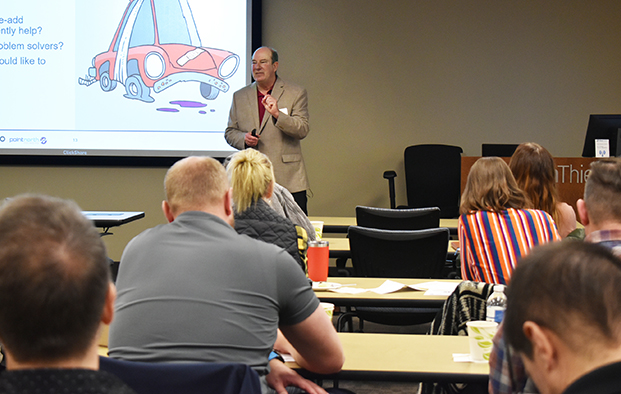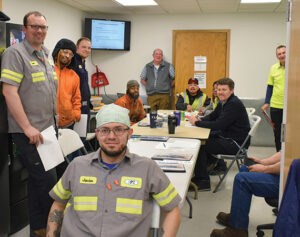When I talk with clients about how they can begin or enhance their continuous improvement (CI) efforts, I always ask them to think about how their workday usually starts. Is it focused on customer needs, or is it centered on fighting fires?
For those facing the firefighting scenario on most, or even many days, there’s a reason –— and a solution. If managers and supervisors have become the problem solvers for issues on the manufacturing floor, it’s probably because the value-add employees are not engaged or empowered to identify and solve issues on the spot. It might also mean those employees are tolerating or using Band-Aids for problems that, if they were addressed, could boost efficiency.

When leaders shift responsibility and authority for problem solving and process improvements to employees, everyone in the company can work toward making all the good days even better. It frees managers to work on the company and not in the company; it transforms punch-in, punch-out employees into the drivers of continuous improvement. For the manufacturer, that means higher retention, improved quality, and an edge over competitors.
Empowering production employees in this way is straightforward, but requires thoughtful, step-by-step implementation. Assessing engagement levels, boosting communication, and developing proper goals and measures form the foundation of this approach to continuous improvement. This groundwork helps employees identify the waste in processes that might prevent them from reaching their goals. Finally, they can give them the authority to brainstorm and attempt problem-solving measures to eliminate waste, improve processes, and boost productivity.
Now is the time
Employee-driven continuous improvement can help attract and retain employees, as well as ensure customer satisfaction by delivering quality products on time and within budgeted costs.
Once employees are genuinely engaged as problem solvers, supervisors aren’t putting out fires every day. Instead, they can direct their attention to the company’s growth.
At the same time, engaged employees have much higher retention rates, which limits the need for costly training of new hires. Quality improves when the workforce has lower turnover because the company can more effectively standardize processes.
Assess employee engagement
Engaged employees are the key to implementing specific CI steps to reduce waste and improve processes. As a starting point, they should determine how well employees are connected to the company’s mission, vision, and values.
Leaders often spend a lot of time communicating corporate values to their teams. Even if employees cannot repeat the company’s mission, vision, and values exactly, the key is that they are truly driven to meet customers’ needs. Those needs are easily defined: Did customers get what they ordered, on time, and was the quality what was promised? That baseline gives employees a strong enough connection to the mission to dive into continuous improvement.
The other component of engagement is how employees are treated. Do they have a sense of belonging? Do they believe their ideas are valued? Do they feel like they’re part of a team? An atmosphere of belonging helps employees feel trust when they raise issues about waste and process improvement.
Next, determine if employees know specific company goals. Do production employees know, for example, if the company is trying to boost market share by 10%? Do they know the company’s overall growth goal? Their knowledge of key objectives is a clear sign of engagement, and it will be important as leaders connect individuals and their specific goals to those of the entire company.
I often visit manufacturing companies in which management has posted metrics, but they don’t have goals related to them.
Communicate big and small issues
It’s also critical to keep employees up to date on issues that directly and immediately impact the manufacturing floor. I often hear from the value-add people, “It would have been great if they had told us about this huge order coming,” or “I wish I had known that we had some supply issues that could hold us up.”
Quick daily meetings about such matters can make a huge difference in engaging employees and improving their days. I often recommend a “first five” gathering at the beginning of each day. It should take no more than five minutes to outline upcoming challenges: a quality issue with some material that should be monitored; someone will be out the next week on vacation; several orders at once might lead to some overtime next week.
Before sending employees off to their work areas, managers can cap off that update with a “high five” acknowledgment of what they did well. It’s not long or involved, but it’s the kind of communication that makes everyone feel connected, and it limits surprises.

Measure right
With a foundation of engagement and communication, manufacturers can develop and post specific goals and metrics surrounding those goals. Often though, leaders miss the mark on those measures.
I often visit manufacturing companies in which management has posted metrics, but they don’t have goals related to them. Companies might have a board with data on quality, cost, delivery, and safety, but the metrics are at a level that people in production don’t know what they can do to affect any of that.
If on-time shipping is a goal, the floor employee can’t control if the shipping department is short-staffed or if they ran out of cardboard boxes and had to substitute something else that took a long time to fabricate. Instead, leaders should develop goals that the employees do have control over.
Employees will better relate to metrics that are localized to just one department or one work center rather than overall on-time shipping. Call it schedule attainment. If an employee has three work orders at the beginning of the day and gets all three done, it was a productive day.
Good metrics can fuel the next step in the CI journey. If employees know where they stand for the metrics they can affect, they can tie their own goal to the company’s strategic metric of increasing market share, for example. When they are consistently ahead at their own work centers, the company can bring more work in, maybe even capture some of the competition’s work.
Teach employees to find waste
All of these steps work together to help employees identify waste, the key component of employee-driven problem solving.
I was on a manufacturing floor recently, helping a company through this process. Our first step in identifying waste was to have the employees observe. One group just watched another group running the machine centers. Half the team was on the project, and the other half was continuing with their day. We just stood there and watched what everyone else was doing.
A key takeaway from the exercise was realizing how much time they spent walking. They had to keep going back to a computer to check engineering drawings or confirm dimensions on the parts. It was a 75-foot walk each time, and standing back to watch really drove home how much time they were wasting.
It turns out they had the infrastructure to move the computer to the workstation and cut out all that walking time. They figured they spent about 30 minutes a day walking, and there are four workstations, so that change could free up two hours a day.
Problem solving in action
Employees also noticed other reasons they were walking so much and offered ideas to cut down that waste as well.
After each work order was completed, for example, someone walked to the supervisor for another assignment. Instead, they suggested keeping all work orders for the day at their stations to eliminate that wasted time.
They also found that once they started a job, they spent a lot of time walking to and from the tool crib to get the right tools. Someone suggested assigning an employee — but not a highly-paid machinist — to serve as a runner to get those tools, freeing up their time to complete jobs. They also set up a tool cart with all the standard tools needed for most jobs. They kept that right next to the workstation. For unusual tools, specific to only some projects, the tool runner could step in.
Company leaders were pleasantly surprised by how engaged and excited the employees were when given the chance to offer input on improving processes. In fact, they generated so many ideas that they needed a process to test solutions. I recommend using the four-step process of plan, do, check, and adjust. Through brainstorming the team can develop a plan. I always suggest they come up with at least three options. If one fails, they can move to another and keep trying. One of them is going to work better than the others.
After the team comes up with possible changes, they will follow with doing — quickly attempting what they think is the best of the three solutions. Once they find one that works best, they can do it on a small scale and check results. If it does everything they want, that’s great, and they might be able to use it in other areas of production. If it doesn’t, but it’s still better than the process used before, or either of the other solutions, then they will move to step four, adjust, to see if they can keep improving it.
Another advantage to heading to the manufacturing floor to observe, brainstorm, and try new processes is that it spreads excitement. In the example I shared, other groups of employees were eager to get in on the action. They were watching what was going on and thinking about what improvements they could make in their own work areas.
There was genuine excitement about the process, and though we were taking it slowly and using the four-step process, we made our project very visible to make sure the enthusiasm carried throughout the whole facility.
Engagement really catches on when everyone wants to be a part of this process. How great would it be for people to come to work excited, knowing that if they have an idea for a good change, they can make it? That they have the power to make a good day an even better day? It’s all within reach if you take the right steps.
Return to the Summer 2024 issue of Enterprise Minnesota® magazine.


